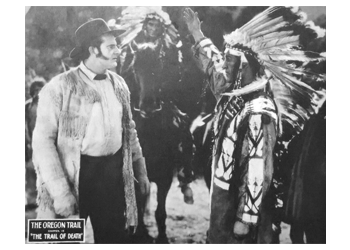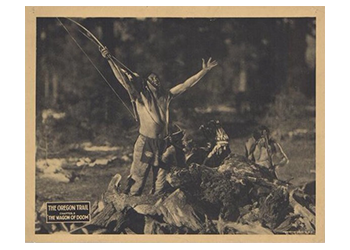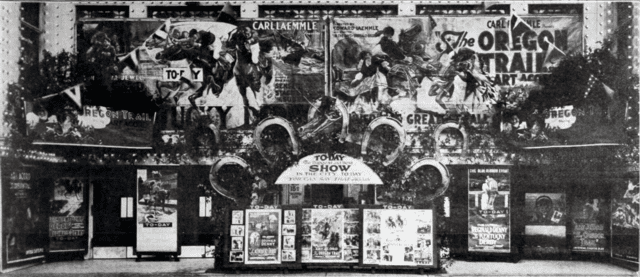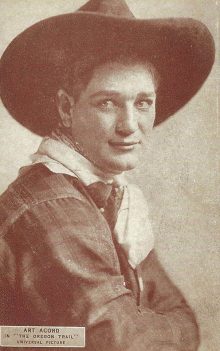O …is for
The Oregon Trail
The longest of Universal’s historical serials that year was the eighteen-part The Oregon Trail (released on March 12). Directed by Ed Laemmle and based on a screenplay by Robert A. Dillon, Anthony Coldeway, Douglas Bronston, and Jefferson Moffitt, it was built around Dr. Marcus Whitman’s effort to bring the Word of God to the Northwest Indians. An American physician and Congregationalist missionary, Whitman led an overland westward party by wagon from New York to Oregon in 1836, a journey that helped to open the Pacific Northwest to settlement. In what is now Washington state, he and his party established mission schools and helped the Native Americans build houses and mills. Whitman’s wife Narcissa Prentiss, also a registered missionary, and Eliza Spaulding, wife of Henry H. Spaulding (a married couple who accompanied the Whitmans), became the first white women to cross the Continental Divide. A few years later, in the winter of 1843, after traveling on horseback to Washington, D.C., to inform federal officials about conditions in Oregon, Whitman returned to the West and, with a caravan of immigrants in what was called the “great migration,” was part of the first wagons to cross the mountains to the Columbia River.
Starring in the serial was popular silent film star Art Acord, playing a trapper who fights a vicious syndicate, and his real-life wife Louise Lorraine. Acord, who had started his professional career stunting with the Dick Stanley and the Buffalo Bill Wild West Shows, quickly found a place as a rider and stunt man in early films and earned a reputation as a Western film star. Beginning with his first serial The Moon Riders (1920) and in later ones such as In the Days of Buffalo Bill (1922), he proved himself as durable a screen hero as his close friend Hoot Gibson. Although Acord did not survive the transition to sound Westerns, his mark on silent and serial Westerns was indelible. Similarly, former stage actress Louise Lorraine (sometimes billed as “Louise Fortune”) showed herself to be a capable heroine, who—despite her small stature—performed many of her own stunts. But she never made a real mark in the pictures, certainly never approaching the stardom of Pearl White or Ruth Roland; and she retired soon after the silent era came to an end.
Survival Status: Presumed lost.
Director: Ed Laemmle
Release Date: March 12, 1923
Release Company: Universal Pictures Corporation
Cast: Art Acord (Jean Brulet), Louise Lorraine (Rosita Velasquez), Duke R. Lee (Dr. Marcus Whitman), Jim Corey (Rene Coulier), Burton C. Law (Reverend Henry Spaulding), Sidney DeGray (Hernandez Velasquez), Ruth Royce (Narcissa Prentiss), Grace McLean (Mrs. Spaulding), Dick Carter (Dr. William Gray), Walter Bytell, William Ryno, Frederick Peters, Jerry (Rex the Wonder Dog), Fleetwood (Fleetwood the Horse)
Episodes: 1. Westward Ho! (in three reels, with the rest of the episodes in two reels). 2. White Treachery. 3. Across The Continent. 4. Message of Death. 5. Wagon of Doom. 6. Secret Foes. 7. A Man of God. 8. Seeds of Civilization. 9. Justice. 10. The New Era. 11. A Game of Nations. 12. To Save An Empire. 13. Trail of Death. 14. On To Washington. 15. Santa Fe. 16. Fate of A Nation. 17. For High Stakes. 18. Victory.




